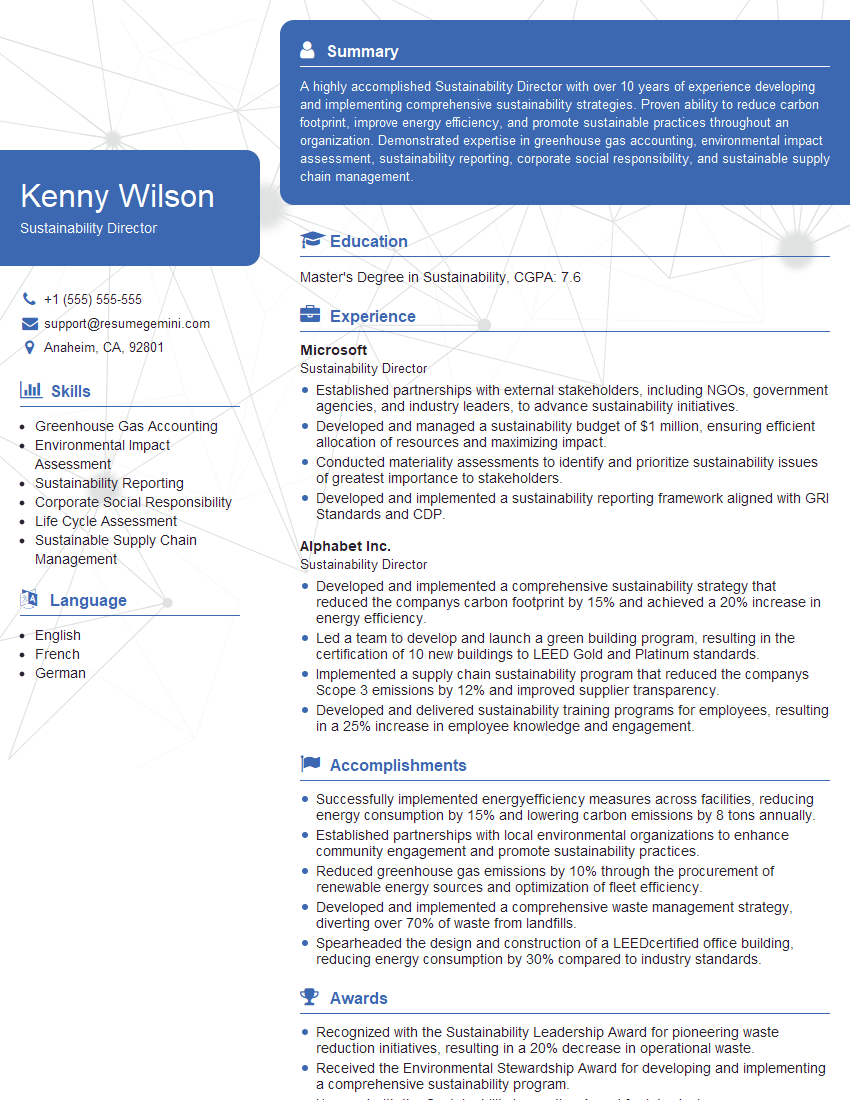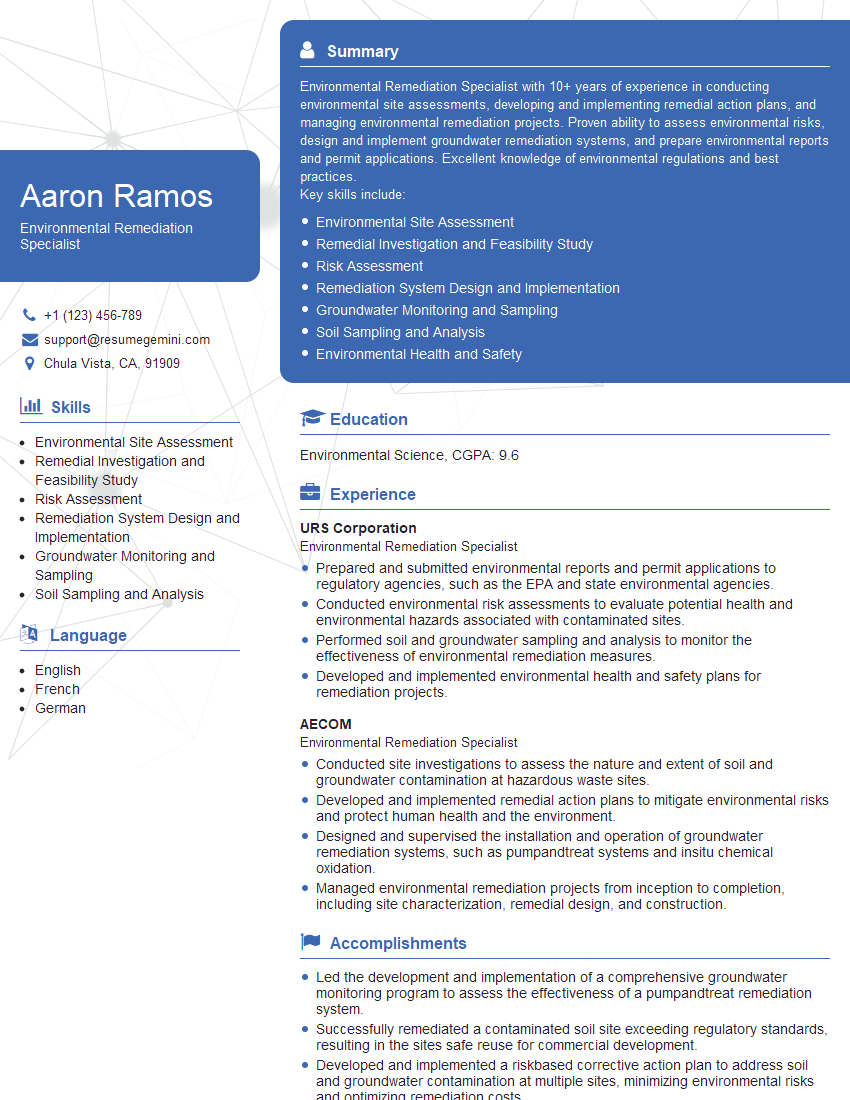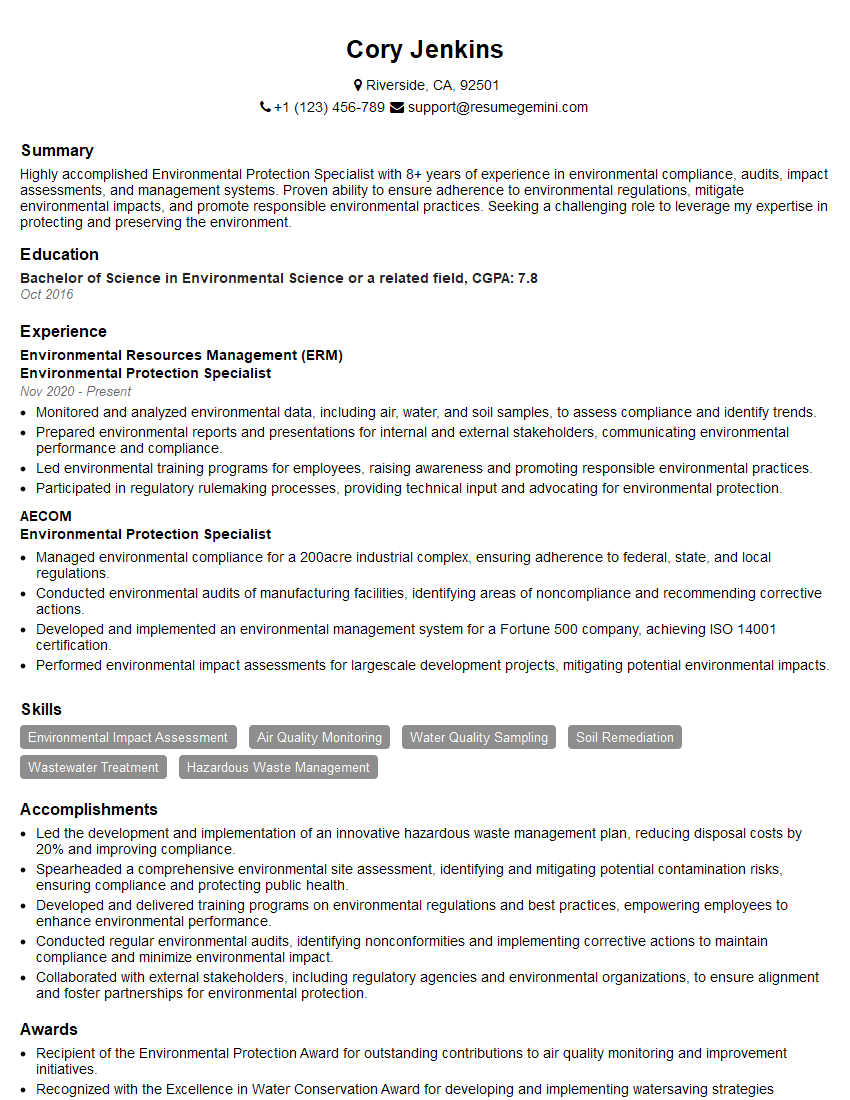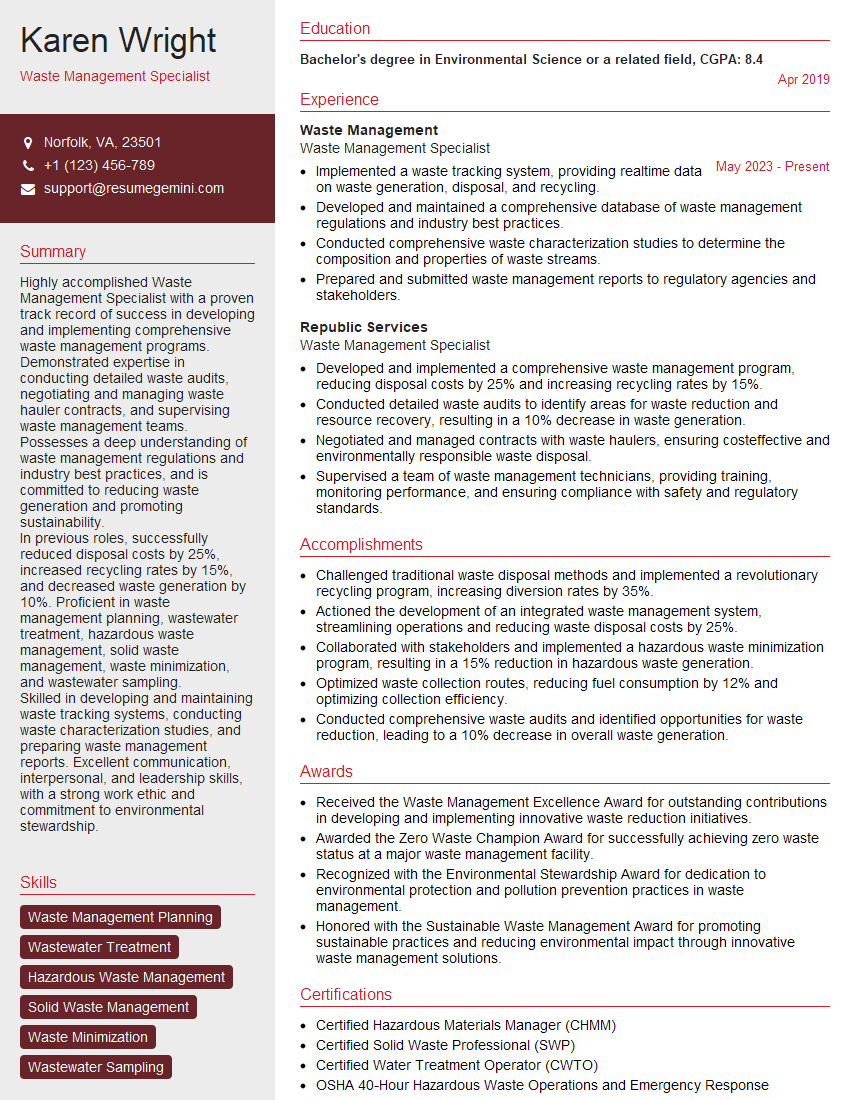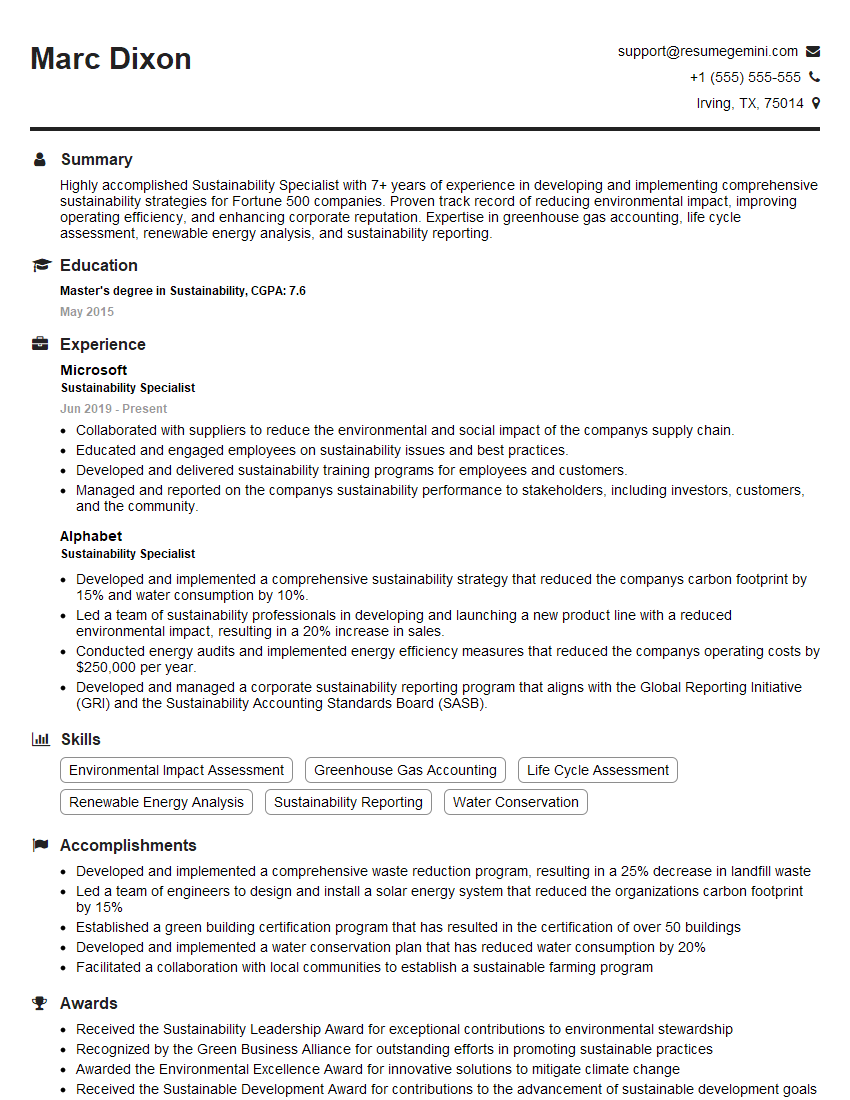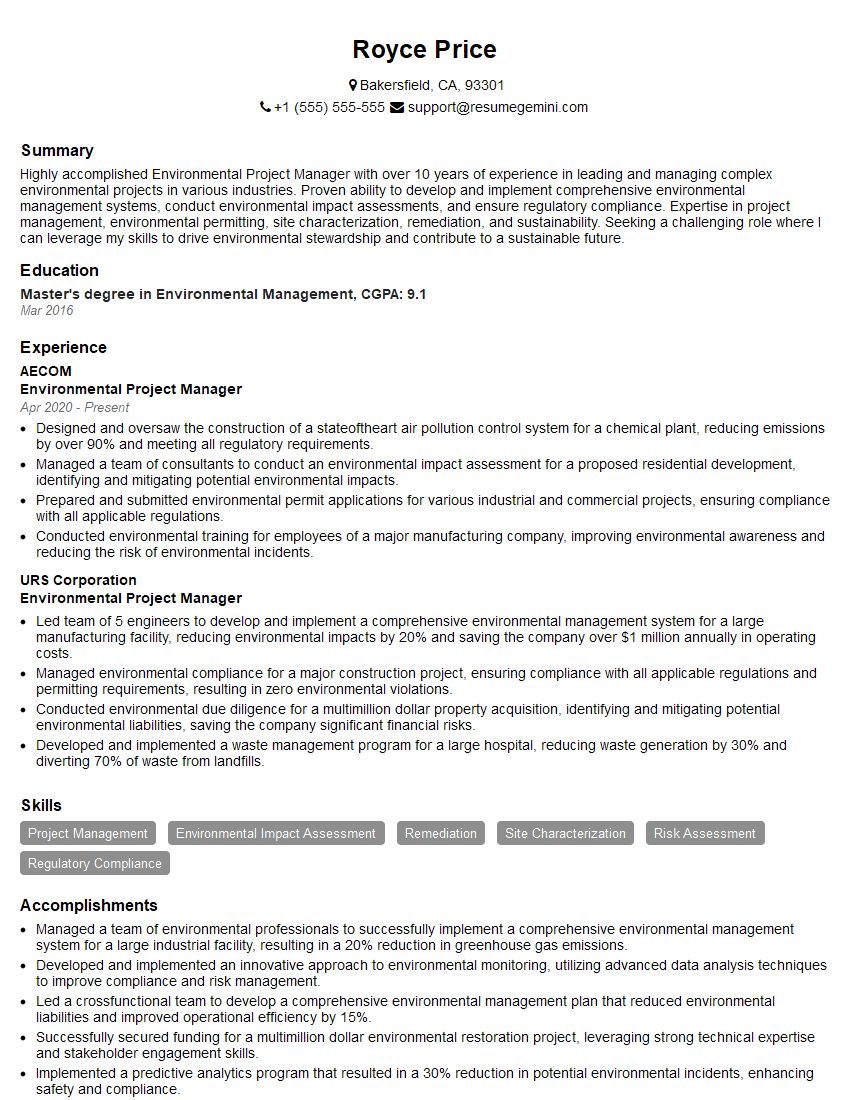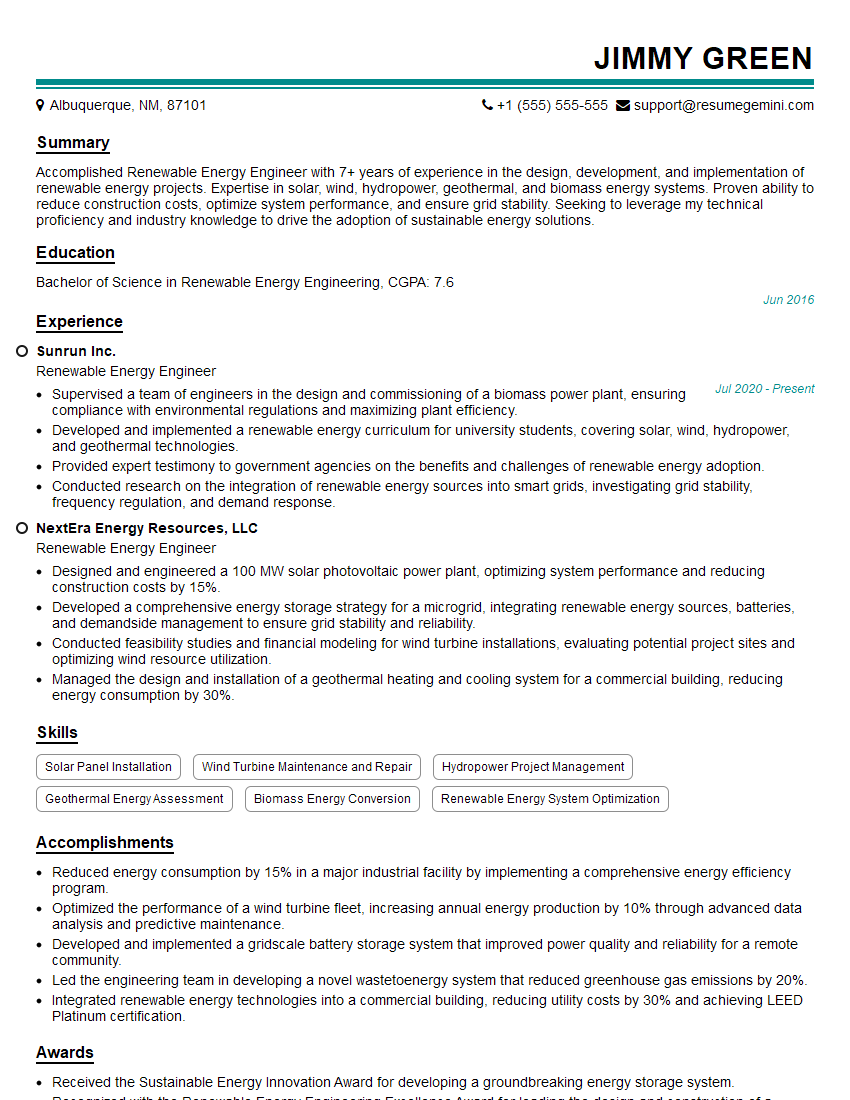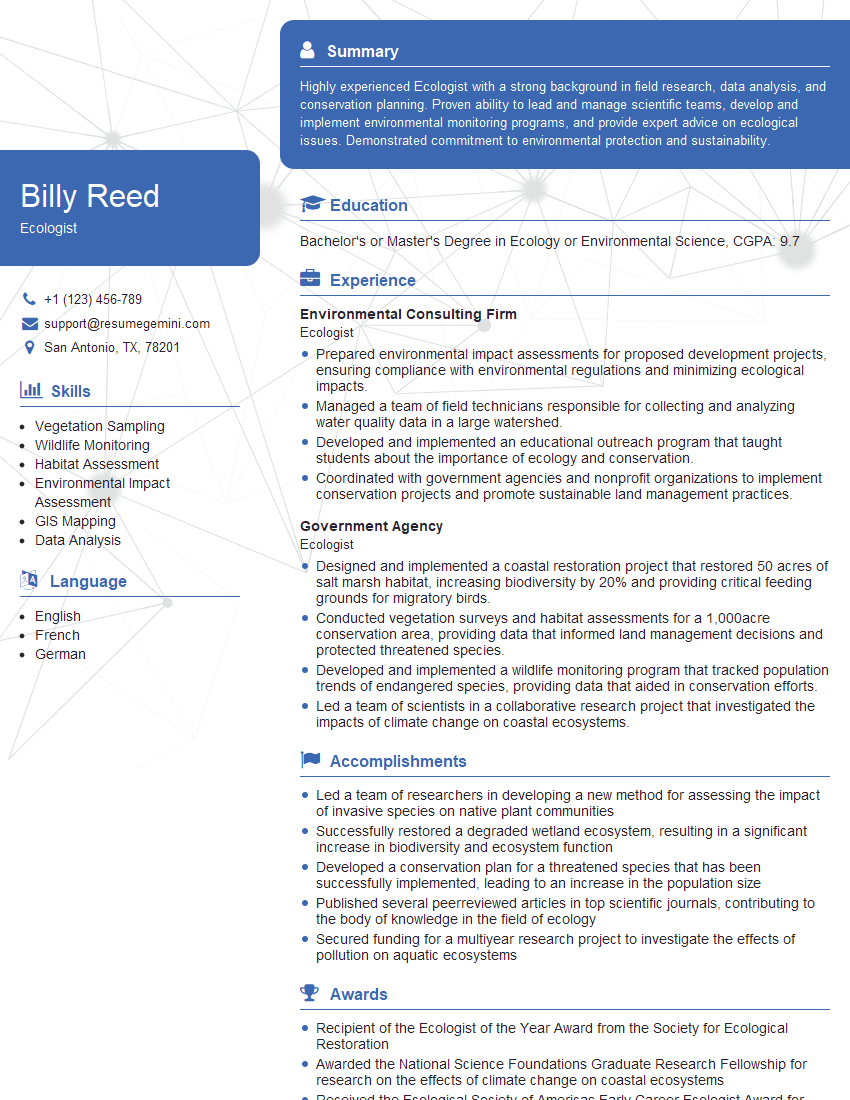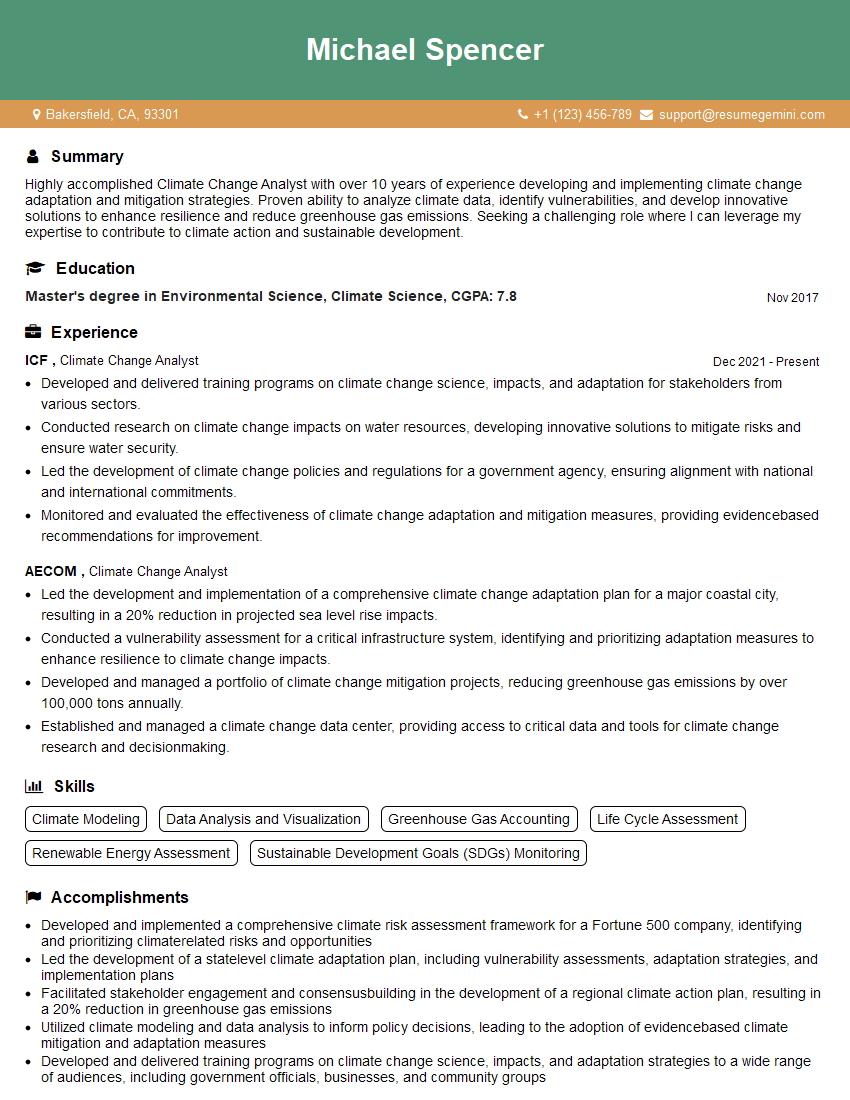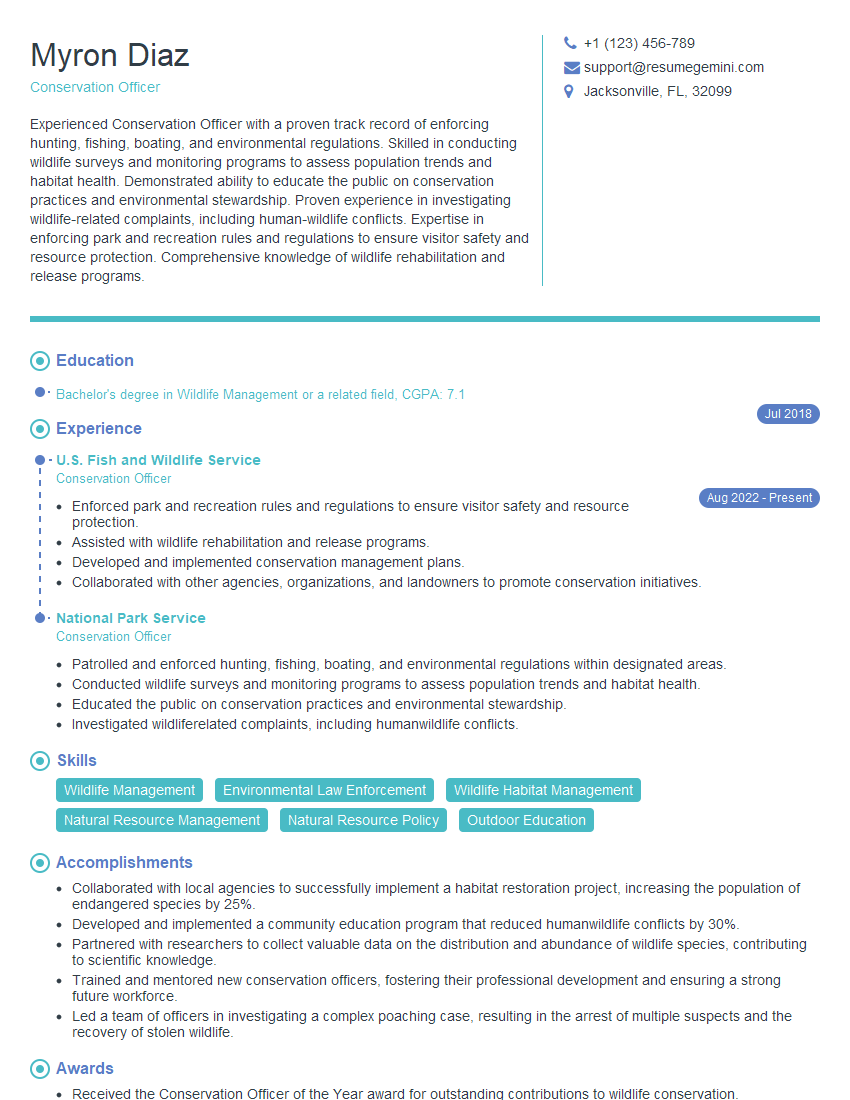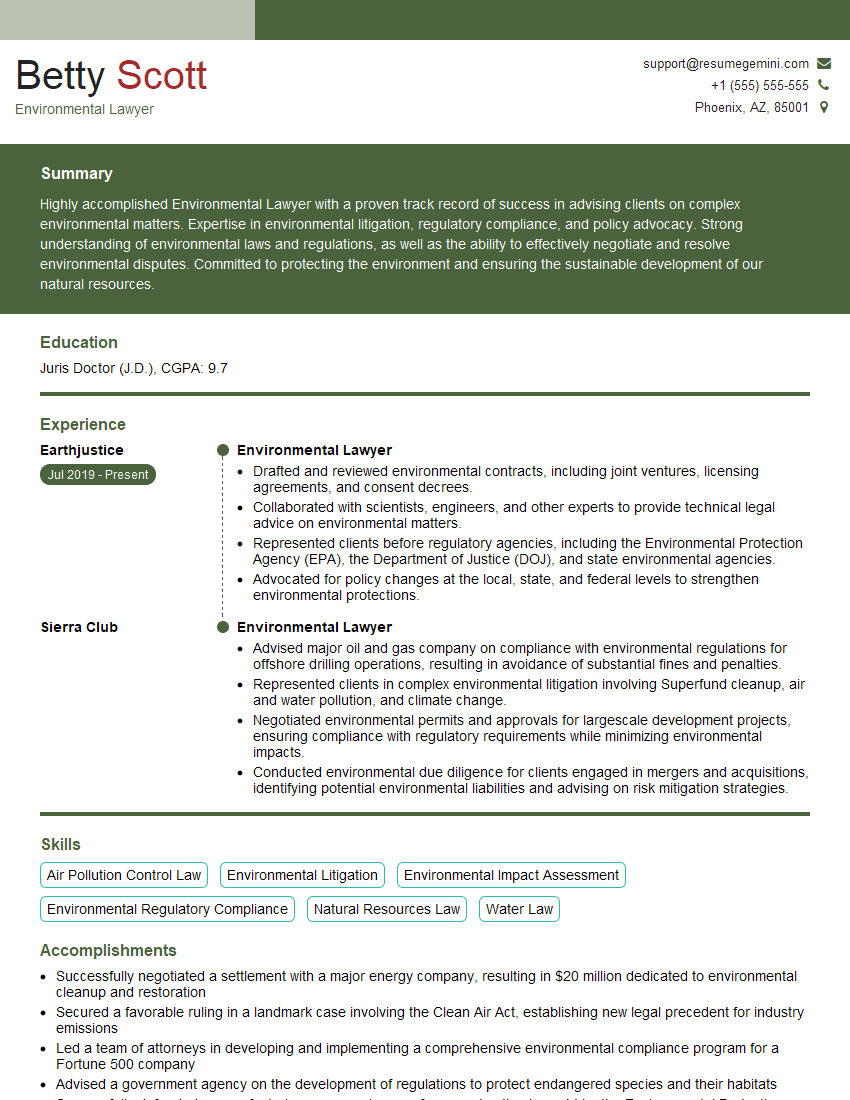Interviews are more than just a Q&A session—they’re a chance to prove your worth. This blog dives into essential Passion for the environment interview questions and expert tips to help you align your answers with what hiring managers are looking for. Start preparing to shine!
Questions Asked in Passion for the environment Interview
Q 1. Explain your understanding of the greenhouse effect and its impact on the environment.
The greenhouse effect is a natural process that warms the Earth’s surface. When the Sun’s energy reaches the Earth’s atmosphere, some of it is reflected back to space and the rest is absorbed and re-radiated by greenhouse gases. These gases, such as carbon dioxide, methane, and nitrous oxide, trap heat in the atmosphere, much like the glass roof of a greenhouse traps heat inside. This trapped heat is essential for life on Earth, keeping the average temperature suitable for humans and other organisms. However, human activities, primarily the burning of fossil fuels, deforestation, and industrial processes, have significantly increased the concentration of greenhouse gases in the atmosphere, leading to an enhanced greenhouse effect and global warming. This amplified effect results in climate change, causing a range of environmental impacts including rising sea levels, more frequent and intense heatwaves, changes in precipitation patterns, ocean acidification, and disruptions to ecosystems.
Imagine wrapping the Earth in an increasingly thick blanket. The blanket (greenhouse gases) keeps more and more heat in, resulting in a warmer planet. This warmth is not evenly distributed, leading to unpredictable and often devastating weather events.
Q 2. Describe different renewable energy sources and their advantages and disadvantages.
Renewable energy sources are naturally replenished and sustainable alternatives to fossil fuels. Several key sources exist, each with its own advantages and disadvantages:
- Solar Power: Uses photovoltaic cells to convert sunlight into electricity. Advantages: Abundant, low maintenance, reducing carbon footprint. Disadvantages: Intermittency (sunlight dependent), land use requirements, manufacturing impacts.
- Wind Power: Uses wind turbines to convert wind energy into electricity. Advantages: Clean, relatively low cost, can be located offshore or onshore. Disadvantages: Intermittency (wind dependent), visual impact, potential noise pollution.
- Hydropower: Uses the energy of flowing water to generate electricity. Advantages: Reliable, relatively low cost, long lifespan. Disadvantages: Environmental impact on river ecosystems, potential for displacement of communities, dependence on water availability.
- Geothermal Energy: Harvests heat from the Earth’s interior. Advantages: Reliable, consistent energy output, low carbon emissions. Disadvantages: Geographic limitations, potential for induced seismicity (earthquakes).
- Biomass Energy: Uses organic matter (wood, crops, waste) to generate energy. Advantages: Sustainable if managed responsibly, can utilize waste materials. Disadvantages: Potential for deforestation, air pollution if not managed properly, lower energy density compared to fossil fuels.
The choice of renewable energy source depends on factors such as geographic location, available resources, and environmental impact considerations. A diversified approach, often referred to as an energy mix, is frequently employed to optimize efficiency and minimize risks.
Q 3. What are the key principles of sustainable development?
Sustainable development aims to meet the needs of the present without compromising the ability of future generations to meet their own needs. This encompasses three key interconnected principles:
- Environmental Protection: Conserving natural resources, reducing pollution, protecting biodiversity, and mitigating climate change. This involves careful resource management, waste reduction, and the implementation of environmentally friendly technologies.
- Economic Viability: Ensuring economic growth and development that is environmentally sustainable. This means creating jobs that are aligned with environmental protection, promoting green businesses, and fostering innovation in sustainable technologies. This avoids a trade-off between economic growth and environmental responsibility.
- Social Equity: Promoting social justice, equality, and access to resources for all members of society. This includes ensuring fair distribution of environmental benefits and costs, addressing environmental injustices, and improving the well-being of communities. This considers the social impact of environmental policies and projects.
These principles are intertwined and interdependent. Sustainable development requires a holistic approach that addresses environmental, economic, and social dimensions simultaneously. For example, investing in renewable energy technologies protects the environment (environmental), generates jobs (economic), and improves air quality, leading to better public health (social).
Q 4. How would you assess the environmental impact of a proposed project?
Assessing the environmental impact of a proposed project requires a systematic approach, often involving an Environmental Impact Assessment (EIA). This process typically involves the following steps:
- Scoping: Identifying the potential environmental impacts of the project.
- Baseline Studies: Gathering data on the existing environmental conditions in the project area.
- Impact Prediction: Assessing the magnitude and significance of potential impacts (positive and negative).
- Mitigation Measures: Identifying strategies to avoid, minimize, or compensate for negative impacts.
- Monitoring and Evaluation: Tracking the actual environmental impacts of the project during and after implementation.
- Reporting: Documenting the findings of the EIA and making it publicly available.
Tools used in EIAs include life cycle assessments (LCAs) that evaluate the environmental impacts across the entire life cycle of a product or process, and environmental risk assessments that quantify and manage the probability and consequences of potential environmental harms. The goal is to make informed decisions about whether the project should proceed, and if so, how to minimize its negative environmental footprint.
Q 5. What are some common environmental regulations and compliance requirements?
Environmental regulations and compliance requirements vary significantly by country, region, and the specific type of activity. However, some common examples include:
- Air Quality Regulations: Limiting emissions of pollutants from industrial sources, vehicles, and other sources.
- Water Quality Regulations: Protecting water bodies from pollution through discharge permits and water quality standards.
- Waste Management Regulations: Managing hazardous and non-hazardous waste, including recycling, composting, and landfill regulations.
- Endangered Species Protection: Laws and regulations designed to protect endangered and threatened species and their habitats.
- Climate Change Regulations: Regulations to reduce greenhouse gas emissions and promote renewable energy.
Compliance involves obtaining necessary permits, adhering to emission limits, conducting regular monitoring, and reporting to regulatory agencies. Failure to comply can result in penalties, fines, and legal action. Staying up-to-date with relevant regulations and working with environmental consultants is crucial for ensuring compliance.
Q 6. Explain your understanding of carbon footprint and its reduction strategies.
A carbon footprint is the total amount of greenhouse gases (primarily carbon dioxide) generated by our actions. It encompasses emissions from energy consumption, transportation, food production, and other activities. Reducing our carbon footprint is crucial for mitigating climate change. Strategies for reduction include:
- Energy Efficiency: Improving energy efficiency in buildings, transportation, and industrial processes. This involves using energy-efficient appliances, improving insulation, and promoting public transportation.
- Renewable Energy Transition: Shifting from fossil fuels to renewable energy sources such as solar, wind, and hydropower.
- Sustainable Transportation: Reducing reliance on private vehicles by using public transportation, cycling, walking, or carpooling. Choosing electric or hybrid vehicles is also an important aspect.
- Sustainable Diets: Reducing meat consumption, particularly red meat, and choosing locally sourced food to reduce emissions associated with food production and transportation.
- Carbon Offsetting: Investing in projects that remove carbon dioxide from the atmosphere, such as reforestation or carbon capture technologies.
Reducing our carbon footprint requires a multi-pronged approach involving individual actions, policy changes, and technological innovations. It’s a collective responsibility requiring collaboration across all sectors.
Q 7. Describe different waste management techniques and their effectiveness.
Waste management techniques aim to minimize environmental harm and maximize resource recovery. Common techniques include:
- Landfilling: The disposal of waste in designated landfills. Effectiveness: Relatively inexpensive but can lead to groundwater contamination and methane emissions if not properly managed. Modern landfills incorporate liners and gas collection systems to mitigate these issues.
- Incineration: Burning waste at high temperatures to reduce volume and generate energy. Effectiveness: Reduces waste volume significantly but can produce air pollution if not equipped with proper pollution control technologies. Energy recovery from incineration is a significant advantage.
- Recycling: Processing waste materials to create new products. Effectiveness: Conserves resources, reduces landfill waste, and reduces the need for virgin materials. However, recycling processes can consume energy and create pollution, so optimization and effective sorting are essential.
- Composting: Decomposing organic waste (food scraps, yard waste) to create a soil amendment. Effectiveness: Reduces landfill waste, creates valuable fertilizer, and reduces greenhouse gas emissions.
- Anaerobic Digestion: Breaking down organic matter in the absence of oxygen to produce biogas (methane) and digestate (fertilizer). Effectiveness: Generates renewable energy and valuable fertilizer, reducing landfill waste and greenhouse gas emissions. Best suited for large-scale operations.
The most effective waste management strategies involve a combination of techniques, prioritizing waste reduction, reuse, recycling, and recovery before resorting to disposal methods like landfilling or incineration. This integrated approach, often called waste hierarchy, is essential for achieving sustainable waste management.
Q 8. What is your experience with environmental monitoring and data analysis?
Environmental monitoring and data analysis are crucial for understanding and addressing environmental challenges. My experience encompasses designing and implementing monitoring programs, collecting and managing diverse datasets (water quality, air quality, soil composition, biodiversity indices), and applying statistical and spatial analysis techniques to interpret trends and identify significant patterns. For example, I’ve worked on a project tracking deforestation rates in the Amazon using satellite imagery and GIS software, correlating deforestation with changes in rainfall patterns and identifying areas needing immediate conservation efforts. Another project involved analyzing water quality data from a polluted river basin, identifying pollution sources, and recommending remediation strategies based on statistical modeling.
- Data Acquisition: This includes using various sensors, remote sensing techniques (satellite imagery, drones), and field sampling methods.
- Data Processing: Cleaning, validating, and transforming raw data into usable formats using software like R, Python, and ArcGIS.
- Data Analysis: Applying statistical methods (regression, ANOVA, time series analysis), spatial analysis (GIS), and machine learning techniques to identify trends, correlations, and anomalies.
- Reporting and Visualization: Creating clear and concise reports and visualizations to communicate findings to stakeholders.
Q 9. How familiar are you with Life Cycle Assessment (LCA)?
Life Cycle Assessment (LCA) is a standardized method for evaluating the environmental impacts of a product or service throughout its entire lifecycle, from raw material extraction to disposal. I’m very familiar with the ISO 14040/44 standards guiding LCA practices. My understanding includes all stages of an LCA: Goal and Scope Definition, Inventory Analysis (identifying all inputs and outputs), Impact Assessment (quantifying environmental impacts using various impact categories like climate change, eutrophication, acidification), and Interpretation.
For instance, I’ve conducted LCAs for various products, comparing the environmental performance of different packaging materials (plastic vs. paper) to guide sustainable packaging choices for a major food company. This involved collecting data on energy consumption, water usage, emissions, and waste generation throughout each material’s lifecycle. The results guided a shift towards more environmentally friendly packaging options, significantly reducing the company’s carbon footprint.
Q 10. How do you approach conflict resolution related to environmental issues?
Environmental conflict resolution requires a multi-faceted approach that prioritizes collaborative problem-solving. My approach focuses on fostering open communication, active listening, and building trust among stakeholders with often conflicting interests (e.g., environmental groups, industries, local communities, government agencies).
I utilize various conflict resolution techniques, including:
- Mediation: Facilitating dialogues between opposing parties to find mutually acceptable solutions.
- Negotiation: Working with stakeholders to identify common ground and reach compromises.
- Collaborative problem-solving: Engaging stakeholders in a participatory process to develop integrated solutions.
For example, I successfully mediated a dispute between a logging company and a local community concerned about deforestation. Through facilitated discussions, we developed a sustainable forestry plan that balanced economic needs with ecological protection, leading to a win-win outcome for all parties involved.
Q 11. What is your understanding of biodiversity and its importance?
Biodiversity refers to the variety of life on Earth at all its levels, from genes to ecosystems. It encompasses the evolutionary, ecological, and cultural processes that sustain life. Biodiversity is fundamentally important for several reasons:
- Ecosystem Services: Biodiversity underpins essential ecosystem services, including clean air and water, pollination, climate regulation, and nutrient cycling.
- Economic Value: Biodiversity provides significant economic benefits through agriculture, forestry, fisheries, tourism, and pharmaceuticals.
- Human Well-being: Biodiversity is essential for human health, food security, and cultural heritage.
- Resilience: A more biodiverse ecosystem is more resilient to environmental changes, such as climate change and invasive species.
The decline in biodiversity poses a significant threat to human well-being and the stability of our planet. Protecting and restoring biodiversity requires integrated conservation strategies that address habitat loss, pollution, climate change, and overexploitation of natural resources.
Q 12. Explain different approaches to pollution control and remediation.
Pollution control and remediation involve a range of approaches tailored to the specific pollutant and environmental context. Strategies can be categorized into:
- Prevention: This focuses on minimizing pollution at its source, e.g., implementing cleaner production technologies in industries, improving waste management practices, and promoting sustainable agriculture.
- Control: This involves reducing pollution levels through various methods such as installing air and water treatment systems, using emission control technologies, and regulating industrial discharges.
- Remediation: This focuses on cleaning up existing pollution, e.g., using bioremediation techniques (using microorganisms to break down pollutants), phytoremediation (using plants to absorb contaminants), or physical removal of contaminated soil or water.
For instance, the remediation of a contaminated site might involve a combination of excavation of contaminated soil, followed by bioremediation to further break down remaining pollutants, and finally, monitoring to ensure the site is safe. Choosing the optimal approach requires a thorough site assessment, understanding the nature and extent of the contamination, and considering economic and technical feasibility.
Q 13. What are your views on the role of technology in environmental conservation?
Technology plays a transformative role in environmental conservation, providing innovative solutions to monitor, manage, and mitigate environmental problems. Examples include:
- Remote Sensing and GIS: Monitoring deforestation, pollution levels, and changes in biodiversity using satellite imagery and geographic information systems.
- Sensor Networks: Real-time monitoring of air and water quality, providing early warning systems for pollution events.
- Precision Agriculture: Optimizing resource use (water, fertilizers, pesticides) in agriculture through technology-driven approaches, reducing environmental impacts.
- Renewable Energy Technologies: Transitioning to clean energy sources, reducing greenhouse gas emissions.
- Biotechnology: Developing bioremediation techniques to clean up pollution, creating sustainable materials, and improving crop yields.
However, it’s crucial to acknowledge that technology alone is insufficient. Its effective deployment requires a holistic approach that considers social, economic, and ethical dimensions, ensuring equitable access and responsible use.
Q 14. How can businesses improve their environmental sustainability?
Businesses can significantly improve their environmental sustainability through a multi-pronged strategy focused on integrating environmental considerations into all aspects of their operations.
- Sustainable Supply Chains: Sourcing materials responsibly, minimizing waste, and promoting sustainable practices throughout their supply chain.
- Energy Efficiency: Reducing energy consumption through energy-efficient technologies and practices.
- Waste Reduction and Recycling: Minimizing waste generation and implementing robust recycling programs.
- Water Conservation: Implementing water-efficient technologies and practices to reduce water consumption.
- Carbon Footprint Reduction: Measuring and reducing greenhouse gas emissions through energy efficiency, renewable energy adoption, and carbon offsetting.
- Product Lifecycle Management: Designing products for durability, repairability, and recyclability, extending product lifecycles.
- Transparency and Reporting: Publicly reporting environmental performance and engaging in transparent communication with stakeholders.
Adopting a circular economy model, focusing on resource efficiency and waste minimization, is key for long-term sustainability. Investing in environmental management systems like ISO 14001 can provide a structured framework for improving environmental performance.
Q 15. What is your experience with environmental education and outreach?
My experience in environmental education and outreach spans over a decade, encompassing diverse roles from designing and delivering workshops for schoolchildren to developing and implementing community-based conservation programs. I’ve worked with various stakeholders, including government agencies, NGOs, and private sector companies, to communicate complex environmental issues in accessible and engaging ways. For example, I developed a curriculum for middle school students on sustainable agriculture, which involved hands-on activities like composting and hydroponics, resulting in a significant increase in student understanding and engagement. I also led a community initiative to promote recycling and waste reduction, using public awareness campaigns and collaborative partnerships with local businesses. This resulted in a measurable decrease in landfill waste within the target community. My approach emphasizes experiential learning and community participation to foster long-term behavioral change and environmental stewardship.
Career Expert Tips:
- Ace those interviews! Prepare effectively by reviewing the Top 50 Most Common Interview Questions on ResumeGemini.
- Navigate your job search with confidence! Explore a wide range of Career Tips on ResumeGemini. Learn about common challenges and recommendations to overcome them.
- Craft the perfect resume! Master the Art of Resume Writing with ResumeGemini’s guide. Showcase your unique qualifications and achievements effectively.
- Don’t miss out on holiday savings! Build your dream resume with ResumeGemini’s ATS optimized templates.
Q 16. Describe your understanding of climate change mitigation and adaptation.
Climate change mitigation focuses on reducing greenhouse gas emissions to slow down or prevent the progression of climate change. This involves transitioning to renewable energy sources like solar and wind power, improving energy efficiency in buildings and transportation, and adopting sustainable agricultural practices to reduce methane emissions. Adaptation, on the other hand, involves adjusting to the effects of climate change that are already happening or are unavoidable. This might include building seawalls to protect against rising sea levels, developing drought-resistant crops, or implementing early warning systems for extreme weather events. Both mitigation and adaptation are crucial for addressing climate change effectively. Imagine a coastal community facing rising sea levels. Mitigation efforts would focus on globally reducing emissions to slow sea level rise, while adaptation would involve building defenses like seawalls and relocating vulnerable infrastructure.
Q 17. What are the key challenges in achieving environmental sustainability?
Achieving environmental sustainability faces several interconnected challenges. One major hurdle is the inherent conflict between economic growth and environmental protection. The pursuit of economic development often leads to increased resource consumption and pollution, creating a trade-off with environmental sustainability. Another critical challenge is the global nature of environmental problems. Climate change, for example, transcends national borders, requiring international cooperation for effective solutions. Furthermore, issues of environmental justice, where marginalized communities disproportionately bear the brunt of environmental damage, pose significant ethical and social challenges. Finally, a lack of awareness, misinformation, and insufficient political will can hinder the implementation of necessary policies and changes in behavior. Addressing these challenges requires a multi-faceted approach encompassing policy changes, technological innovation, social engagement, and a shift towards more sustainable consumption patterns.
Q 18. Explain the concept of circular economy and its relevance to sustainability.
A circular economy is an economic model that aims to minimize waste and maximize resource utilization. Instead of a linear ‘take-make-dispose’ model, the circular economy emphasizes designing out waste and pollution, keeping products and materials in use, and regenerating natural systems. This involves strategies like product lifecycle management (designing products for durability, repairability, and recyclability), resource recovery (recycling and reusing materials), and waste prevention. The relevance to sustainability is profound because it reduces our dependence on virgin resources, minimizes pollution, and creates a more resilient and environmentally friendly economy. For example, a clothing company adopting a circular economy model might use recycled materials, offer clothing repair services, and implement take-back programs for end-of-life garments, rather than simply discarding them.
Q 19. How would you prioritize environmental projects with competing demands?
Prioritizing environmental projects with competing demands requires a structured approach. I would use a multi-criteria decision analysis (MCDA) framework, incorporating factors like environmental impact, cost-effectiveness, feasibility, community engagement, and alignment with broader strategic goals. Each project would be assessed against these criteria, using a scoring system or ranking method to determine their relative priority. This systematic approach ensures transparency and objectivity, allowing for a data-driven decision-making process. For instance, if faced with choosing between a project to restore a degraded wetland and a project to improve air quality in a city, I would assess each based on factors like the extent of ecological damage, the number of people affected, and the cost of implementation, before making an informed decision.
Q 20. What is your approach to risk assessment and management in environmental projects?
My approach to risk assessment and management in environmental projects involves a proactive and iterative process. First, I would identify potential hazards and vulnerabilities through thorough site assessments, stakeholder consultations, and review of relevant literature. Then, I would analyze the likelihood and potential consequences of each risk, using qualitative and quantitative methods. Based on this risk assessment, I would develop a risk management plan, outlining mitigation strategies, contingency plans, and monitoring procedures. This plan would be regularly reviewed and updated as the project progresses. For example, in a project involving wetland restoration, I would assess risks like flooding, invasive species, and changes in water quality, developing mitigation strategies like installing flood control measures, implementing invasive species management plans, and setting up monitoring systems to track water quality parameters.
Q 21. How would you handle disagreements within a team regarding environmental practices?
Handling disagreements within a team regarding environmental practices requires open communication, respect for diverse perspectives, and a collaborative problem-solving approach. I would facilitate a constructive dialogue where team members can clearly express their viewpoints, supported by evidence and data. We would explore the root causes of the disagreement and identify shared goals and values. A collaborative decision-making process, perhaps using a consensus-building approach or a structured conflict resolution technique, would help find a mutually agreeable solution. It’s crucial to emphasize the importance of respecting different viewpoints and working towards a shared vision of environmental stewardship. The goal isn’t necessarily to eliminate disagreements entirely but to manage them constructively to arrive at the best possible outcome for the environment and the project.
Q 22. What is your experience with environmental impact statements and reports?
Environmental Impact Statements (EIS) and reports are crucial documents assessing the potential effects of proposed projects on the environment. They’re legally mandated for many large-scale developments and are used to inform decision-making processes. My experience involves reviewing and contributing to numerous EIS, focusing on areas like air and water quality, biodiversity, and greenhouse gas emissions. This includes analyzing baseline data, predicting impacts using modeling software, and proposing mitigation strategies. For example, I worked on an EIS for a new highway where we modeled the impact on local wetlands and developed a plan for habitat restoration to offset losses. This involved extensive fieldwork, data analysis using GIS software, and collaboration with regulatory agencies and stakeholders.
I’m proficient in interpreting complex data sets, evaluating the validity of methodologies used in EIS, and identifying potential biases or gaps in the assessment. My work ensures compliance with relevant regulations and best practices and promotes informed decision-making that balances development with environmental protection.
Q 23. Describe your understanding of the precautionary principle in environmental management.
The precautionary principle is a guiding philosophy in environmental management, stating that when an activity raises threats of harm to human health or the environment, precautionary measures should be taken even if some cause-and-effect relationships are not fully established scientifically. It’s essentially about erring on the side of caution. Instead of waiting for conclusive proof of harm before acting, this principle encourages proactive measures to prevent potential damage. This is particularly relevant when dealing with complex environmental systems where uncertainty is high, such as the effects of new chemicals or genetically modified organisms.
A practical application would be regulating the release of a new chemical into the environment even with incomplete toxicological data. The precautionary principle would prioritize public and environmental safety, potentially through stringent testing and monitoring protocols, even if absolute certainty regarding its harmfulness is lacking. This principle promotes a proactive, preventative approach to environmental management, prioritizing risk reduction over the potential economic benefits of ignoring potential harms.
Q 24. What are your thoughts on the role of government policy in environmental protection?
Government policy plays a vital role in environmental protection, setting the framework for environmental regulations, enforcement, and investment in sustainable solutions. Strong environmental policies are essential to set targets for emissions reductions, protect biodiversity, and manage natural resources sustainably. These policies can take various forms, including legislation, regulations, permits, and incentives. Examples include carbon pricing mechanisms (like carbon taxes or cap-and-trade systems), regulations on pollution emissions, and policies promoting renewable energy development.
Effective policy requires a robust regulatory system to enforce standards and a collaborative approach that engages stakeholders. Furthermore, it requires sufficient funding and resources to implement and monitor policies effectively. Weak enforcement or lack of funding can render even the most ambitious policies ineffective. The success of environmental policy relies on both strong regulations and a commitment from all levels of government and the public to actively participate in the transition to environmental sustainability.
Q 25. What are some emerging trends in environmental technology and innovation?
The field of environmental technology is rapidly evolving, with exciting advancements driving sustainable solutions. Several key trends are shaping this landscape:
- Artificial Intelligence (AI) and Machine Learning (ML): AI and ML are revolutionizing environmental monitoring, prediction, and management by analyzing large datasets to identify patterns and optimize resource use. For example, AI can predict wildfires based on weather patterns and vegetation conditions.
- Precision Agriculture: Technologies like drones and sensors are optimizing farming practices, reducing water and fertilizer use, and minimizing environmental impact. This leads to increased efficiency and reduced environmental footprint.
- Renewable Energy Technologies: Continual improvements in solar, wind, and other renewable energy sources are making them more efficient and cost-competitive, accelerating the transition towards cleaner energy systems.
- Green Building Materials and Technologies: Innovation in building materials and design is lowering the environmental footprint of construction, leading to more energy-efficient and sustainable buildings.
- Bioremediation and Circular Economy: Bioremediation uses biological organisms to clean up pollution, while the circular economy focuses on reducing waste and maximizing resource utilization.
These advancements offer immense potential for addressing environmental challenges and promoting sustainable development.
Q 26. How would you measure the success of an environmental initiative?
Measuring the success of an environmental initiative requires a multi-faceted approach, using both qualitative and quantitative indicators. It depends heavily on the specific goals of the initiative but generally involves:
- Quantitative Metrics: These include measurable outcomes like reductions in greenhouse gas emissions, improvements in water quality, increased biodiversity, or decreased waste generation. For example, a reforestation project might measure its success by the number of trees planted, the increase in forest cover, or the improved carbon sequestration.
- Qualitative Metrics: These assess changes in attitudes, behaviors, and policies. Examples include increased public awareness of environmental issues, shifts in community practices towards sustainability, or policy changes supporting environmental protection.
- Cost-Benefit Analysis: Evaluating the economic and social benefits of the initiative relative to its costs is also crucial. This can help determine the efficiency and effectiveness of resource allocation.
- Stakeholder Engagement: Assessing stakeholder satisfaction and their perception of the initiative’s impact provides valuable insights into its effectiveness and acceptance.
A comprehensive evaluation needs to integrate all these aspects to provide a holistic assessment of success. Regular monitoring and evaluation are critical for adaptation and improvement.
Q 27. What are your strategies for continuous learning in the field of environmental science?
Continuous learning is paramount in the dynamic field of environmental science. My strategies include:
- Staying updated with scientific literature: I regularly read peer-reviewed journals, attend conferences, and participate in webinars to stay abreast of the latest research and advancements.
- Networking with professionals: Engaging with colleagues, researchers, and experts through professional organizations and collaborations fosters knowledge exchange and keeps me up to date on current challenges and solutions.
- Online courses and certifications: Platforms offering specialized courses in environmental science and technology allow me to acquire new skills and deepen my existing knowledge base.
- Practical experience: Hands-on experience in environmental projects is essential to apply theoretical knowledge and further enhance my skills.
- Mentorship: Seeking guidance and feedback from experienced professionals helps refine my approach and identify areas for improvement.
A commitment to continuous learning ensures I maintain a high level of expertise and adapt to the ever-evolving nature of environmental challenges.
Q 28. Describe a time you had to overcome a challenge in an environmental project.
During a project assessing the impact of agricultural runoff on a coastal ecosystem, we faced significant challenges in securing reliable data. Local farmers were initially hesitant to share information due to concerns about potential regulations and penalties. To overcome this, we implemented a multi-pronged strategy:
- Building trust and rapport: We spent considerable time engaging with the farmers, explaining the project’s objectives and emphasizing the collaborative nature of the research. We held meetings, answered questions openly, and addressed their concerns.
- Offering incentives: We offered to provide farmers with customized reports summarizing their individual data and recommendations for improving their practices. This created a value exchange.
- Community engagement: We organized workshops and presentations, involving local community leaders and stakeholders, to build consensus and foster a sense of shared responsibility.
By employing this participatory approach, we successfully built trust, gathered the necessary data, and achieved the project’s objectives while creating a positive relationship with the local farming community. This experience highlighted the importance of community engagement and building trust in overcoming challenges related to data acquisition and stakeholder participation in environmental projects.
Key Topics to Learn for Passion for the Environment Interview
- Environmental Sustainability: Understanding core principles, global initiatives (e.g., SDGs), and the role of various sectors in achieving sustainability.
- Climate Change Mitigation and Adaptation: Knowledge of greenhouse gas emissions, renewable energy sources, carbon capture technologies, and strategies for adapting to climate change impacts.
- Conservation Biology and Biodiversity: Familiarization with biodiversity hotspots, conservation strategies (e.g., habitat restoration, species protection), and the impact of human activities on ecosystems.
- Environmental Policy and Legislation: Understanding key environmental regulations, international agreements, and policy frameworks relevant to your target role.
- Waste Management and Circular Economy: Knowledge of waste reduction strategies, recycling processes, and the principles of a circular economy.
- Pollution Control and Remediation: Understanding different types of pollution (air, water, soil), their sources, and methods for prevention and remediation.
- Environmental Impact Assessment (EIA): Familiarity with the process of conducting EIAs and evaluating the environmental impacts of projects.
- Sustainable Development Goals (SDGs): Understanding the interconnectedness of the SDGs and how they relate to environmental sustainability.
- Practical Application: Prepare examples showcasing your understanding through projects, volunteer work, or academic studies demonstrating your commitment and problem-solving skills in these areas.
- Problem-Solving Approach: Practice articulating your approach to environmental challenges, highlighting your analytical skills and ability to develop effective solutions.
Next Steps
Demonstrating a genuine passion for the environment is crucial for career advancement in this field. A strong understanding of these key areas will significantly boost your interview performance and open doors to exciting opportunities. To maximize your chances, focus on creating an ATS-friendly resume that effectively highlights your skills and experience. ResumeGemini is a trusted resource that can help you build a professional and impactful resume. Examples of resumes tailored to showcasing a passion for the environment are available to guide you through the process.
Explore more articles
Users Rating of Our Blogs
Share Your Experience
We value your feedback! Please rate our content and share your thoughts (optional).
What Readers Say About Our Blog
Take a look at this stunning 2-bedroom apartment perfectly situated NYC’s coveted Hudson Yards!
https://bit.ly/Lovely2BedsApartmentHudsonYards
Live Rent Free!
https://bit.ly/LiveRentFREE
Interesting Article, I liked the depth of knowledge you’ve shared.
Helpful, thanks for sharing.
Hi, I represent a social media marketing agency and liked your blog
Hi, I represent an SEO company that specialises in getting you AI citations and higher rankings on Google. I’d like to offer you a 100% free SEO audit for your website. Would you be interested?
